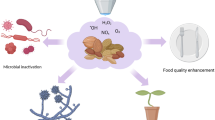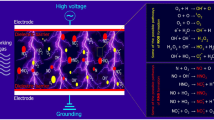Abstract
In recent years, global nut, spice, and herb productions have developed rapidly, and consumption has also increased. During the same period, a massive outbreak of food pathogens was linked to nuts, spices, herbs, and their products, leading to a major change in the way those products are processed. Cold plasma is a new technology used in food processing, which can improve the safety and extend shelf-life of product. A variety of active substances generated by cold plasma can act on microorganisms at ambient temperature and even on complex geometric shapes and heat-sensitive materials without leaving any chemical residues. The chapter introduces the application of various plasma discharge modes (plasma jets, dielectric barrier discharges, and microwave-driven discharges) on surface decontamination of nuts, spices, and herbs. In addition, a brief overview of the effect on their surface color, antioxidation activities, and other qualities with cold plasma treatment. We believe that cold plasma has a wide application prospect in extending the shelf-life and maintaining the quality of these dried foods.
Access this chapter
Tax calculation will be finalised at checkout
Purchases are for personal use only
Similar content being viewed by others
References
Alves EG, Silva LMA, Oiram F et al (2019) Cold plasma processing effect on cashew nuts composition and allergenicity. Food Res Int 125:108621
Amini M, Ghoranneviss M (2016a) Effects of cold plasma treatment on antioxidants activity, phenolic contents and shelf life of fresh and dried walnut (Juglans regia L.) cultivars during storage. LWT 73:178–184
Amini M, Ghoranneviss M (2016b) Black and green tea decontamination by cold plasma. Res J Microbiol 11(1):42–46
Amini M, Ghoranneviss M, Abdijadid S (2017) Effect of cold plasma on crocin esters and volatile compounds of saffron. Food Chem 235(235):290–293
Arrus K, Blank G, Abramson D et al (2005) Aflatoxin production by Aspergillus flavus in Brazil nuts. J Stored Products Res 41(5):513–527
Basaran P, Basaran N, Oksuz L (2008) Elimination of Aspergillus parasiticus from nut surface with low pressure cold plasma (LPCP) treatment. Food Microbiol 25(4):626–632
Buckenhuskes HJ, Rendlen M (2004) Hygienic problems of phytogenic raw materials for food production with special emphasis to herbs and spices. Food Sci Biotechnol 13:262–268
Choi EJ, Yang HS, Park HW et al (2018) Inactivation of Escherichia coli O157:H7 and Staphylococcus aureus in red pepper powder using a combination of radio frequency thermal and indirect dielectric barrier discharge plasma non-thermal treatments. LWT 93:477–484
Danyluk MD, Jones TM, Abd SJ et al (2007) Prevalence and amounts of Salmonella found on raw California almonds. J Food Protect 70(4):820–827
Dasan BG, Mutlu M, Boyaci IH (2016) Decontamination of Aspergillus flavus and Aspergillus parasiticus spores on hazelnuts via atmospheric pressure fluidized bed plasma reactor. Int J Food Microbiol 216:50–59
Dasan BG, Boyaci IH, Mutlu M (2017) Nonthermal plasma treatment of Aspergillus spp. spores on hazelnuts in an atmospheric pressure fluidized bed plasma system: impact of process parameters and surveillance of the residual viability of spores. J Food Eng 196:139–149
Deng S, Ruan R, Mok CK et al (2007) Inactivation of Escherichia coli on almonds using nonthermal plasma. J Food Sci 72(2):62–66
Devi Y, Thirumdas R, Sarangapani C et al (2017) Influence of cold plasma on fungal growth and aflatoxins production on groundnuts. Food Control 77:187–191
Filtenborg O, Frisvad JC, Thrane U (1996) Moulds in food spoilage. Int J Food Microbiol 33(1):85–102
Fine F, Gervais P (2005) Thermal destruction of dried vegetative yeast cells and dried bacterial spores in a convective hot air flow: strong influence of initial water activity. Environ Microbiol 7(1):40–46
Fisher MC, Henk DA, Briggs CJ et al (2012) Emerging fungal threats to animal, plant and ecosystem health. Nature 484(7393):186–194
Fisher MC, Gow NA, Gurr SJ (2016) Tackling emerging fungal threats to animal health, food security and ecosystem resilience. Biol Sci 371(1709):1–6
Frelka JC, Harris LJ (2014) Nuts and nut pastes. The microbiological safety of low water activity foods and spices. Springer, New York, pp 213–244
Garcia S, Iracheta F, Galvan F et al (2001) Microbiological survey of retail herbs and spices from Mexican markets. J Food Prot 64(1):99–103
Gurtler JB, Doyle MP, Kornacki JL (2014) The microbiological safety of low water activity foods and spices. Springer, New York
Harborne JB, Williams CA (2000) Advances in flavonoid research since 1992. Phytochemistry 55(6):481–504
Hertwig C, Reineke K, Ehlbeck J et al (2015a) Impact of remote plasma treatment on natural microbial load and quality parameters of selected herbs and spices. J Food Eng 167:12–17
Hertwig C, Reineke K, Ehlbeck J et al (2015b) Decontamination of whole black pepper using different cold atmospheric pressure plasma applications. Food Control 55:221–229
Hertwig C, Leslie A, Meneses N et al (2017) Inactivation of Salmonella enteritidis PT30 on the surface of unpeeled almonds by cold plasma. Innov Food Sci Emerg Technol 44:242–248
Hosseini SI, Farrokhi N, Shokri K et al (2018) Cold low pressure O2 plasma treatment of Crocus sativus: an efficient way to eliminate toxicogenic fungi with minor effect on molecular and cellular properties of saffron. Food Chem 257:310–315
Isaacs S, Aramini J, Ciebin B et al (2005) An international outbreak of salmonellosis associated with raw almonds contaminated with a rare phage type of Salmonella Enteritidis. J Food Prot 68(1):191–198
Kashfi AS, Ramezan Y, Khani MR (2020) Simultaneous study of the antioxidant activity, microbial decontamination and color of dried peppermint (Mentha piperita L.) using low pressure cold plasma. LWT 123:109121
Kim JE, Lee DU, Min SC (2014) Microbial decontamination of red pepper powder by cold plasma. Food Microbiol 38:128–136
Kim JE, Choi H, Lee D et al (2017a) Effects of processing parameters on the inactivation of Bacillus cereus spores on red pepper (Capsicum annum L.) flakes by microwave-combined cold plasma treatment. Int J Food Microbiol 263:61–66
Kim JE, Oh YJ, Won MY et al (2017b) Microbial decontamination of onion powder using microwave-powered cold plasma treatments. Food Microbiol 62:112–123
Lee JH, Sung TH, Lee KT et al (2004) Effect of gamma-irradiation on color, pungency, and volatiles of Korean red pepper powder. J Food Sci 69(8):585–592
Lerouge S, Wertheimer MR, Yahia LH (2001) Plasma sterilization: a review of parameters, mechanisms, and limitations. Plasmas Polym 6(3):175–188
Mendes C, Costa J, Vicente A et al (2016) Cashew nut allergy: clinical relevance and allergen characterization. Clin Rev Allergy Immunol 57:1–22
Mosovska S, Medvecka V, Halaszova N et al (2018) Cold atmospheric pressure ambient air plasma inhibition of pathogenic bacteria on the surface of black pepper. Food Res Int 106:862–869
Mošovská S, Medvecká V, Gregová M et al (2019) Plasma inactivation of Aspergillus flavus on hazelnut surface in a diffuse barrier discharge using different working gases. Food Control 104:256–261
Niemira BA (2012) Cold plasma reduction of Salmonella and Escherichia coli O157:H7 on almonds using ambient pressure gases. J Food Sci 77(3):171–175
Pignata C, D’Angelo D, Basso D et al (2014) Low-temperature, low-pressure gas plasma application on Aspergillus brasiliensis, Escherichia coli and pistachios. J Appl Microbiol 116(5):1137–1148
Prelle A, Spadaro D, Garibaldi A et al (2014) Co-occurrence of aflatoxins and ochratoxin A in spices commercialized in Italy. Food Control 39:192–197
Schweiggert U, Carle R, Schieber A (2007) Conventional and alternative processes for spice production - a review. Trends Food Sci Technol 18(5):260–268
Sen Y, Onal-Ulusoy B, Mutlu M (2019) Aspergillus decontamination in hazelnuts: evaluation of atmospheric and low-pressure plasma technology. Innov Food Sci Emerg Technol 54:235–242
Siciliano I, Spadaro D, Prelle A et al (2016) Use of cold atmospheric plasma to detoxify hazelnuts from aflatoxins. Toxins 8(125):1–10
Sun S, Anderson NM, Keller S (2014) Atmospheric pressure plasma treatment of black peppercorns inoculated with Salmonella and held under controlled storage. J Food Sci 79(12):1–6
Taniwaki MH, Hocking AD, Pitt JI et al (2009) Growth and mycotoxin production by food spoilage fungi under high carbon dioxide and low oxygen atmospheres. Int J Food Microbiol 132(3):100–108
Tateo F, Bononi M (2006) Determination of ethylene chlorohydrin as marker of spices fumigation with ethylene oxide. J Food Compos Anal 19(1):83–87
Venkataratnam H, Sarangapani C, Cahill O et al (2019) Effect of cold plasma treatment on the antigenicity of peanut allergen Ara h 1. Innov Food Sci Emerg Technol 52:368–375
Wogan GN (1966) Chemical nature and biological effects of the aflatoxins. Bacteriol Rev 30(2):460–470
Won MY, Lee SJ, Min SC (2017) Mandarin preservation by microwave-powered cold plasma treatment. Innov Food Sci Emerg Technol 39:25–32
Yun H, Kim B, Jung S et al (2010) Inactivation of Listeria monocytogenes inoculated on disposable plastic tray, aluminum foil, and paper cup by atmospheric pressure plasma. Food Control 21(8):1182–1186
Zarghami NS, Heinz DE (1971) Monoterpene aldehydes and isophorone-related compounds of saffron. Phytochemistry 10(11):2755–2761
Zhang XL, Zhong CS, Mujumdar AS et al (2018) Cold plasma pretreatment enhances drying kinetics and quality attributes of chili pepper (Capsicum annuum L.). J Food Eng 241:51–57
Author information
Authors and Affiliations
Corresponding author
Editor information
Editors and Affiliations
Rights and permissions
Copyright information
© 2022 Zhejiang University Press
About this chapter
Cite this chapter
Yan, W. (2022). Application of Cold Plasma in Nuts, Spices, and Herbs. In: Ding, T., Cullen, P., Yan, W. (eds) Applications of Cold Plasma in Food Safety. Springer, Singapore. https://doi.org/10.1007/978-981-16-1827-7_12
Download citation
DOI: https://doi.org/10.1007/978-981-16-1827-7_12
Published:
Publisher Name: Springer, Singapore
Print ISBN: 978-981-16-1826-0
Online ISBN: 978-981-16-1827-7
eBook Packages: Biomedical and Life SciencesBiomedical and Life Sciences (R0)




